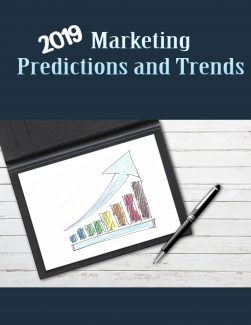
 License Type: Private Label Rights
License Type: Private Label Rights  File Type: ZIP
File Type: ZIP
 SKU: 62412
SKU: 62412  Shipping: Online Download
Shipping: Online Download
Sample Content Preview
Introduction
Almost every marketer wishes they had a crystal ball so they could peer into the future and see what’s hot in the coming year. Unfortunately, most of us are not clairvoyant, but we can usually look at certain current trends and predict which will have staying power. We can also look at emerging technology and how it can be used to further our marketing mission.
In this report, we will be looking at what has happened in 2018 and how it will affect 2019. We will also look at the trends in tech, search engines, and technology and automation.
Top Trends in 2018
Live video
Live video has become increasingly popular. Seeing is believing for a target audience. They also like to feel as though they know the businesses that they are dealing with, and that they are run by real people who are not just out to make money. Looking inside the business and looking into product creation are just a few of the ways to build a relationship with your audience.
Instagram and Snapchat
These continue to grow in popularity, especially amongst 18- to 30-year-olds.
The Smartphone boom
The boom continues, with marketers trying to connect with their prospects in a range of ways, including text and apps.
The rise of chatbots
Chatbots are being used more and more to open and maintain a dialogue with customers, and deliver valuable marketing information.
Facebook Messenger
Facebook Messenger got a much-needed overhaul and marketing push. It is now a much more convenient tool and a handy chatbot if you set it up correctly to respond to trigger words.
Facebook lead ads
These can be one of the fastest ways to grow your email marketing list - provided that you use attractive images, write a good ad, and automate the process of adding the new names to your list to save time. It’s also good for generating leads for Salesforce.com and other customer relations management software.
Storytelling in marketing
Everyone loves a good story. Using storytelling in marketing offers a structure people are familiar with and leads to satisfied customers getting a vision of living happily ever after.
Influencer marketing
This is growing in popularity as more marketers try to connect with their target audience. Influencers with a large number of active followers could be the gateway to a lot more traffic and profits. Even if you pay the influencer to post your content to their followers, the return on investment can be considerable.
Remarketing
Small business owners are catching on to the wonders of remarketing. Facebook pixels are easier than ever to use to track customers from your site and try to convert them from browsers into buyers. Some marketers report a conversion rate as high as 75%. The secret? More customized, varied content, rather than the same messaging they have already seen and acted upon.
Google algorithm changes
The most recent algorithm (formula) change hit on August 1, 2018. Google states that it was intended to give credit to worthy sites that were not getting as much attention as they deserved. While it still looks like a lot of Wikipedia, there have been some changes in placements. As always, the best way to optimize your content is to write naturally. There will be a couple of changes coming up that will affect sites in 2019, and which are worth paying attention to. Let’s look at the landscape for 2019 next.
The Marketing Landscape of 2019
Some of the hot trends of 2019 will continue, while others will also start to take center stage.
Search engine optimization — not keywords, clusters
SEO will now be more about clusters, not keywords. This has been happening more and more in the last few years, but the algorithms are now being specifically set to look for groupings of words, not just isolated words.
Commonly referred to as semantic support, the algorithms will look at words in relation to one another to determine the meaning of a page and the relevance to a search query.
For example, the word "bachelor" actually has four different meanings:
* An unmarried man
* A person with a Bachelor’s degree
* A young knight
* A young male fur seal
If you see the sentence, "The bachelor lay on the beach," there is no clue as to which of the four meanings is intended.
On the other hand, if you say, "The animal behaviorists will be studying the bachelors on the beach at Peel for the next six months and determining their hunting and fishing patterns," then we know that the last meaning is intended. The other words give us clues so that even though the word "seal" is not mentioned, we can still infer it.
There are still arguments over short- versus long-form content. No one can agree on the ideal article or blog post length. Having said that, the longer an article is (650 to 700 words, for example), the more words will be clustered together, including "seal", and the more clues the search engine will get. About 500 words should be enough to get the point across if writers are really pressed for time and struggling to keep their site or blog updated.







